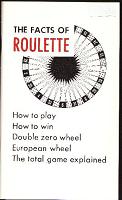
The Facts of Roulette
The Origins of Roulette
The following article is excerpted from The Facts of Blackjack by Walter Nolan. The book is an excellent resource for learning how to play roulette.
The origin of the game of roulette is lost in the dark recesses of history, where factual accounts are difficult to find. Many historians believe that roulette evolved from early games of chance that used a wheel to determine outcomes. E.O. was such a game, and the following paragraph describing E.O. appeared in Modern Hoyle of 1814.
"An E.O. table is circular in form, but of no exact dimensions, tho' in general about four feet in diameter. The extreme circumference is a kind of counter, or depot, for the stakes, marked all around with the letters E and 0, on which each adventurer places money according to his inclination. The interior part of the table consists, first, of a kind of gallery, or rolling-place, for the ball, which, with the outward parts, above, called depot or counter, is stationary or fixed. The most interior part moves upon an axis, or pivot, and is turned about with handles, whilst the ball is set in motion around the gallery. This part is generally divided into 40 niches or interstices, 20 of which are marked with the letter E, and the other 20 with the letter O. The lodging of the ball in any of the niches, distinguished by those letters, determines the wager. The proprietors of the tables have two bar holes, and are obliged to take all bets offered, either for E or 0; but if the ball falls into either of the bar holes, they win all the bets upon the opposite letter, and do not pay to that which it falls; an advantage in the proportion of 2 to 40, or five per cent in their favor."
The game described was first played at Bath, England, in 1739. Who originated it is not known, but it undoubtedly developed from the game of Even or Odd (E.O.), where someone took a handful of buttons, beans, marbles, or whatever was handy, and the opponent tried to guess whether the total was even or odd. With a little ingenuity any simple gambling game can be made into a banking game. Craps, by using a wheel instead of dice, could easily be converted to a roulette-type game.
It is interesting to note that in 1814, writers had trouble figuring percentages. In the set-up explained, the player had nineteen chances of winning, twenty chances of losing, and one chance to break even on a bar, which is disregarded in figuring percentages. Thus, the player's chances are 19 in 39. The bank's advantage is 1 in 39, or 2.56 percent.
While the English played E.O., the French were already playing roulette in the exact form in which it is played today. The relationship between E.O. and roulette is apparent, but it is unknown whether they developed separately or if one is an off-shoot of the other. It has been speculated that the renowned seventeenth-century French mathematician Blaise Pascal invented roulette as a byproduct of work done on a perpetual motion machine. More than likely, roulette developed spontaneously from some other game of chance. Gambling on the turn of wheels has gone on for centuries. Romans turned chariots on their sides and spun the wheels. Ancients spun shields balanced on the points of swords. No doubt spin-the-bottle was once known as spin-the-earthenware-pot.
French-style roulette was introduced in England about 1820, brought over by refugees from the Revolution. Both E.O. and roulette were played at Bath until the greater variety of bets offered by roulette made E.O. obsolete. The 1850 edition of Bohn's Scientific Library doesn't mention E.O., but it does contain a complete and detailed description of roulette as played in casinos today.
It's a 6 to 5 pick whether the English or French introduced the game to the United States. It was probably the French, for New Orleans offered the first real commercial gambling in the United States, and the French have always been more imaginative and enthusiastic in their gambling than the English. It is the French who are responsible for blackjack, chemin de fer, Baccarat, and pari-mutuels.
American roulette is exactly the same game that was played in Europe over two hundred years ago. It was the mainstay of the gambling resorts in New York, Florida, Michigan, Indiana, and other areas before World War II. In the thirties, roulette in Nevada received its fair share of the action. Craps didn't replace it as a more popular game until after the war. Most men in the military service were exposed to barracks craps games, so craps is what they played on visits to Nevada. Today craps tables out-number roulette tables by two and a half to one. Casinos in Atlantic City are offering European-style roulette wheels now as well as American-style wheels. Perhaps this change will regain roulette the great popularity it once enjoyed.
